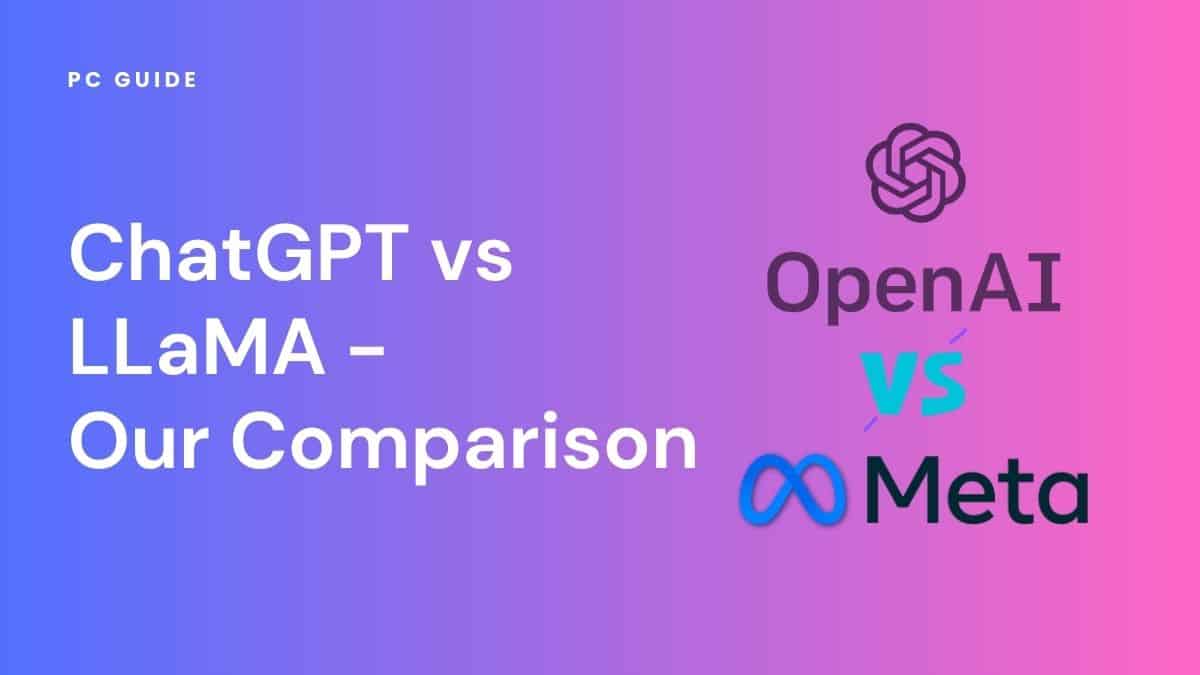ChatGPT vs LLaMA – Our Comparison

Table of Contents
Artificial intelligence (AI) has become an integral part of various industries, with large language models (LLMs) playing a crucial role in generating human-like text. Among some of the most prominent LLMs are Meta’s LLaMA and OpenAI’s ChatGPT. Which AI model is actually better for you, ChatGPT or LLaMA? This article will provide a comprehensive comparison of ChatGPT vs LLaMA, highlighting their similarities, differences, advantages, disadvantages, and potential applications. Without wasting much time, let's get started!
What are LLaMA and ChatGPT?
LLaMA and ChatGPT are both LLMs designed to generate human-like text. They excel in producing coherent and contextually relevant language, making them suitable for a wide range of applications. While they share similarities, there are some distinct features that set each platform apart.
LLaMA, which stands for Large Language Model Meta AI, is a relatively new LLM introduced by Meta. It focuses on efficiency and accessibility, making it more widely available to researchers and organizations. LLaMA is notable for being open-source, with its non-commercial license allowing users to leverage its capabilities for their work. As a result, the model is available to download on Hugging Face and Microsoft Azure.
ChatGPT, on the other hand, is a highly advanced generative AI system developed by OpenAI. It is renowned for its ability to generate natural language text that closely resembles human-written content. ChatGPT can also generate codes in different computer programming languages. This makes it a very versatile and powerful AI chatbot.
Essential AI Tools
ChatGPT vs LLaMA: their operating mechanisms
Both LLaMA and ChatGPT are built on transformers – a type of artificial neural network used in machine learning to analyze and generate new content based on large amounts of data.
The primary distinction between ChatGPT vs LLaMA lies in their size. LLaMA is designed to be efficient and less resource-intensive, making it smaller compared to other LLMs. Although it has fewer parameters, it compensates for this by its efficiency.
ChatGPT, on the other hand, boasts an extensive model size, with GPT-3 boasting over 175 billion parameters. This larger size enhances its ability to generate complex and sophisticated language. However, it also requires substantial computational power.
LLaMA and ChatGPT both use unsupervised learning to train their models. They draw insights from diverse sources of text, such as scientific articles, news articles, and internet text. This variation in training data gives LLaMA an advantage in generating technical or specialized language, while ChatGPT excels in generating informal or conversational language.
ChatGPT vs LLaMA: their advantages and disadvantages
LLaMA and ChatGPT each possess unique advantages and disadvantages that must be considered when selecting the appropriate model for specific use cases. LLaMA’s efficiency and accessibility make it suitable for various applications, such as chatbots, language translation tools, and research purposes.
ChatGPT’s ability to generate complex and nuanced language makes it highly suitable for natural language generation, including creative writing, automated news stories, and the generation of scripts.
However, LLaMA’s limited parameters may hinder its power compared to other LLMs, while ChatGPT’s large size and resource-intensive nature may pose challenges in terms of accessibility and fine-tuning.
ChatGPT vs LLaMA: potential use cases
LLaMA’s efficiency and accessibility make it ideal for applications that require quick and efficient processing, such as chatbots and language translation tools. It also proves beneficial for research purposes, enabling efficient training and testing of models. The open source nature of LLaMA drives innovation, and this move from Meta CEO Mark Zuckerberg is a progressive one for the landscape of the LLM Market.
On the other hand, ChatGPT’s ability to generate sophisticated and nuanced language makes it suitable for various applications. It can be used for content generation for creative writing, automated news stories, and even script generation for movies and TV shows.
The continuous advancements in natural language processing facilitated by LLaMA and ChatGPT have the potential to revolutionize human-machine interactions and communication, paving the way for exciting possibilities in various industries.
Conclusion
LLaMA and ChatGPT are powerful language models based on the transformer neural network architecture. LLaMA’s focus on efficiency and accessibility makes it suitable for a wide range of applications, including chatbots, language translation tools, and research purposes. On the other hand, ChatGPT’s capability to generate complex and nuanced language positions it as a valuable tool for creative writing, automated news stories, and script generation.
While both models have their distinct advantages and disadvantages, the choice between LLaMA and ChatGPT depends on the specific requirements of the user. Researchers and developers need to consider factors such as model size, resource usage, customization options, and availability to make an informed decision.
If you’re interested in more comparisons of the major AI software currently in the market, we’ve also weighed up Google Bard AI vs ChatGPT, as well as Bing AI vs Bard AI.
